SLLSF57A August 2022 – April 2024 TMDS1204
PRODUCTION DATA
- 1
- 1 Features
- 2 Applications
- 3 Description
- 4 Pin Configuration and Functions
- 5 Specifications
- 6 Parameter Measurement Information
-
7 Detailed Description
- 7.1 Functional Block Diagram
- 7.2
Feature Description
- 7.2.1 4-Level Inputs
- 7.2.2 I/O Voltage Level Selection
- 7.2.3 HPD_OUT
- 7.2.4 Lane Control
- 7.2.5 Swap
- 7.2.6 Linear and Limited Redriver
- 7.2.7 Main Link Inputs
- 7.2.8 Receiver Equalizer
- 7.2.9 CTLE Bypass
- 7.2.10 Adaptive Equalization in HDMI 2.1 FRL
- 7.2.11 HDMI 2.1 Link Training Compatible Rx EQ
- 7.2.12 Input Signal Detect
- 7.2.13 Main Link Outputs
- 7.2.14 HDMI DDC Capacitance
- 7.2.15 DisplayPort
- 7.3 Device Functional Modes
- 7.4 Programming
- 7.5 Register Maps
- 8 Application and Implementation
- 9 Device and Documentation Support
- 10Revision History
- 11Mechanical, Packaging, and Orderable Information
Package Options
Mechanical Data (Package|Pins)
- RNQ|40
Thermal pad, mechanical data (Package|Pins)
Orderable Information
6 Parameter Measurement Information
 Figure 6-1 Power-On Timing
Requirements
Figure 6-1 Power-On Timing
Requirements Figure 6-2 TMDS Main Link Test
Circuit
Figure 6-2 TMDS Main Link Test
Circuit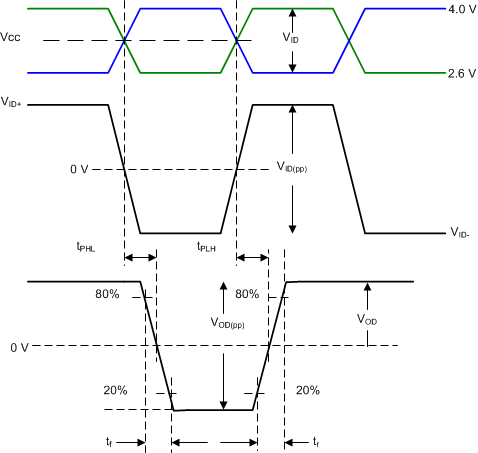 Figure 6-3 Input or Output Timing
Measurements
Figure 6-3 Input or Output Timing
Measurements Figure 6-4 Output Differential
Waveform
Figure 6-4 Output Differential
Waveform Figure 6-5 Output Differential
Waveform with De-Emphasis
Figure 6-5 Output Differential
Waveform with De-Emphasis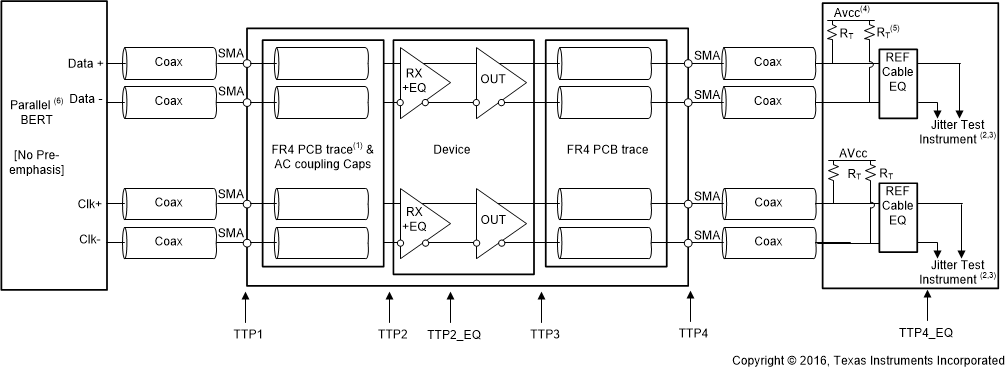
(1) The FR4
trace between TTP1 and TTP2 is designed to emulate 1-12” of FR4, AC-coupling
capacitor, connector and another 2” of FR4. Trace width – 4 mils. 100 Ω
differential impedance.
(2) All
Jitter is measured at a BER of 109. HDMI 2.1 jitter measured at BER 10-10.
(3) Residual
jitter reflects the total jitter measured at TTP4 minus the jitter measured
at TTP
(4) AVCC =
3.3V.
(5)
RT = 50 Ω.
(6) For HDMI
1.4 or 2.0, the input signal from parallel Bert does not have any
pre-emphasis or de-emphasis. For HDMI 2.1 FRL, the input signal from BERT will have 2.18dB
pre-shoot and −3.1dB de-emphasis. Refer to Recommended
Operating Conditions.
Figure 6-6 HDMI Output Jitter
Measurement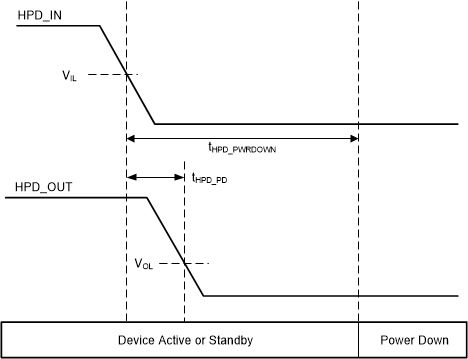 Figure 6-7 HPD Logic Shutdown and
Propagation Timing
Figure 6-7 HPD Logic Shutdown and
Propagation Timing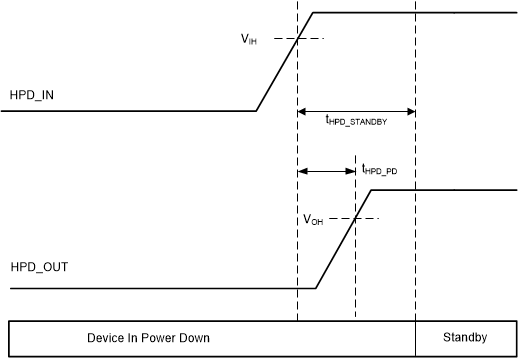 Figure 6-8 HPD Logic Standby and
Propagation Timing
Figure 6-8 HPD Logic Standby and
Propagation Timing Figure 6-9 I2C SCL and SDA
Timing
Figure 6-9 I2C SCL and SDA
Timing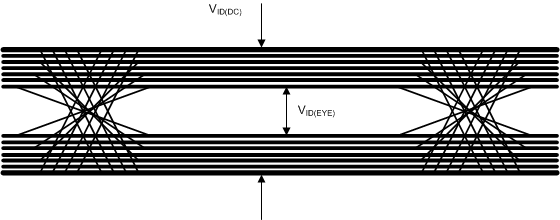 Figure 6-10 VID(DC) and
VID(EYE)
Figure 6-10 VID(DC) and
VID(EYE)